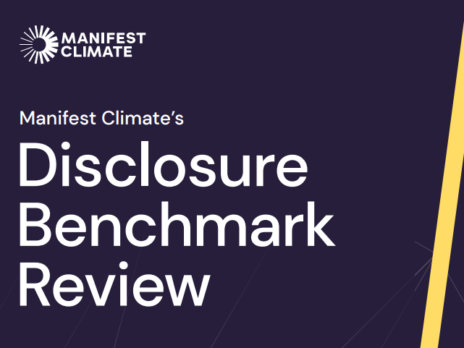

The progress that climate disclosures have made in a short period of time is undeniable. Last year marked five years since the Task Force on Climate-related Financial Disclosures (TCFD) published its final recommendations, a framework that has since either been adopted, or is providing the basis for equivalent regulatory standards, around the world.
Indeed, in a growing number of markets, such disclosures are fast becoming non-negotiable. Last year in the UK, TCFD-aligned climate disclosures were made mandatory for 1,300 of the nation’s largest companies and financial institutions. In the EU, the Corporate Sustainability Reporting Directive (CSRD), passed by the European Parliament in November, will go into effect next year, eventually requiring sustainability-related disclosures from over 50,000 companies.
Even in the US, traditionally something of a laggard in this space, the Securities and Exchange Commission’s (SEC) proposed climate disclosure rule, drawing heavily from the TCFD, has been proposed for all exchange-listed US companies, mandating financial and periodic filings to include information on climate governance, strategy, risk management, and metrics and targets.
The question is fast becoming not whether but rather how one tackles the disclosure challenge, driven in part by these regulatory shifts, but also a growing demand from investors and stakeholders for whom such information is becoming an increasingly critical factor in driving business decisions.
Quality gaps in climate disclosures
But in a space evolving at such speed, something of a dichotomy is also emerging. While corporates prioritise alignment – a process that in many cases requires a significant mindset and operational shift in how climate is addressed – questions are being raised about the actual usefulness of the information they are disclosing.
Climate disclosures done right should provide the markets with the information required to accurately price climate-related financial risks and opportunities. Manifest Climate’s Disclosure Benchmark Review, an assessment of more than 3,000 companies in 65 countries, found that, while rates of TCFD alignment demonstrated steady progress since 2018, a deep dive of over 100 companies’ climate disclosures revealed that just 49% included “decision-useful” information. Not one of the organisations assessed covered all elements required for disclosures to be decision-useful across the TCFD recommendations.
With climate disclosures increasingly becoming mandated, coverage will inevitably continue to increase. The challenge is how one encourages that reporting to look beyond this being a mere box-ticking exercise and embrace the opportunity to surface and articulate information to the market that brings real transparency and insight around how their approach informs the four pillars of TCFD: corporate governance, strategy, risk management, and metrics and targets.
The TCFD itself recognised the challenge in its 2022 Status Report, acknowledging an ongoing concern “that not enough companies are disclosing decision-useful climate-related financial information, which may hinder investors, lenders and insurance underwriters’ efforts to appropriately assess and price climate-related risks.”
Manifest Climate’s finding that just over half of climate disclosures “do not provide enough detail or context for stakeholders to reach an informed understanding of an organisation’s climate preparedness” consolidates such fears, revealing in unprecedented granularity the extent to which a gap has emerged between alignment and quality.
The need for granularity
This applies even to sectors typically more advanced along their climate disclosure journey. Manifest Climate’s alignment assessment found that over 70% of filings by banking and insurance institutions over the period of 2018–21 contained TCFD-aligned information, against 51% of all organisations. However, climate disclosure quality varied widely. In terms of the TCFD’s four pillars, average decision usefulness scores were highest for those linked to strategy (62%) and lowest for the metrics and targets pillar (41%). Governance scored 56%, and risk management 51%.
When those pillars are broken down further, even more variations emerge. Within governance, for example, 88% of enterprises provided decision-useful information on “board oversight”, but only 18% outlined similarly actionable insight on “board decision making”. Under strategy, 72% contained useful information on “climate opportunities”, but only 20% for “climate risks across time”.
These sub-pillar breakdowns tell a story in themselves, drawing a strong distinction between what Manifest Climate defines as “vocal leaders”, those displaying advanced climate management and comprehensive climate disclosures that really consider how and where value is delivered; and “noisy laggards”, enterprises communicating their climate risks and opportunities, but failing to provide greater nuance that drives meaningful action.
But how then does one bring the clarity, specificity, consistency and comparability required to make one’s climate disclosures decision-useful? Significant variations in standards and requirements across the four pillars can even make defining “decision-useful” a challenge.
To start with, Manifest Climate co-founder and CEO Laura Zizzo believes TCFD and similar recommendations should be treated as a “strategic planning framework to stress-test any company's business model and strategy against emerging climate risk and opportunity”. In regard to where financial institutions are failing on strategy, for example, such an approach should include establishing a cross-functional leadership team “to consider how various warming scenarios will impact all aspects of the business, and what strategic decisions will mitigate risk or capitalise on opportunities”.
For governance, one must eschew broad statements of intent and disclose the specifics of how climate change is addressed in the C-suite – and the ways in which climate competency is integrated into the heart of strategic decision making. Regularity of meetings, reporting lines, and incentivisation and accountability should all be considered relevant and valuable.
Tools for change
While more granularity is being called for, one should not run from ambiguity and uncertainty where and when it arises. Acknowledging that one is aware of the areas that require addressing, signals intent and helps to further hone strategy, a message that disclosing companies should feel comfortable communicating to the wider world. “Honesty is more credible than not saying much at all,” says Zizzo.
This journey also requires exposure to, and learning from, best practices, both within one’s own industry and the wider business community. Manifest Climate’s mission is to scale such climate competence and resilience, highlighting and surfacing best practices, providing users and markets with deeper insights into organisations’ climate progress, and inspiring climate actions that accelerate the business world’s preparedness for a climate-adjusted future.
The Manifest Climate platform empowers organisations to understand what actions they can take to improve their climate response. Assessment models, such as those used for the Disclosure Benchmark Review, provide data-driven insights that can help businesses identify their resilience to climate risk, where gaps exist, and what steps are required to enhance the decision-usefulness of their disclosures.
Such tools will be essential if businesses are to move away from equating alignment with competency. The quality, granularity and nuance of one’s climate disclosures – and the insights they provide – will increasingly be a key standard through which one’s entire enterprise is interpreted and judged. Intent and enthusiasm to provide decision-useful, ever-improving climate disclosures should, therefore, be a key strategic driver, both today and into the future.







